Part II – Shipwrecks of Tristan da Cunha
In 1506, a Portuguese navigator sailed his ship around a small island in the South Atlantic Ocean. The waters were rough and he couldn’t go ashore, so he did the next best thing. He named the island after himself. Today, Tristan da Cunha, a small dot on the map between Africa and South America, is recognized as the most remote, inhabited island in the world. Only 6.8 miles in circumference, “Tristan,” as everyone calls it, has only one town, Edinburgh-by-the-Sea. Located at the base of a 6,760-foot volcano, the “Settlement” has 285 residents that form a close knit community. Acclaimed for having no cancer after only one case was discovered in 1853, and no coronavirus, the absence of severe illnesses on the island is attributed to the lifestyle of the “Islanders.” These hard working, self-sufficient people are the impetus for a thriving economy based on rock lobster harvests, postage stamp production and farming. Embraced by fresh air and the lack of crime, it’s a simple life where family comes first and friendships last a lifetime.
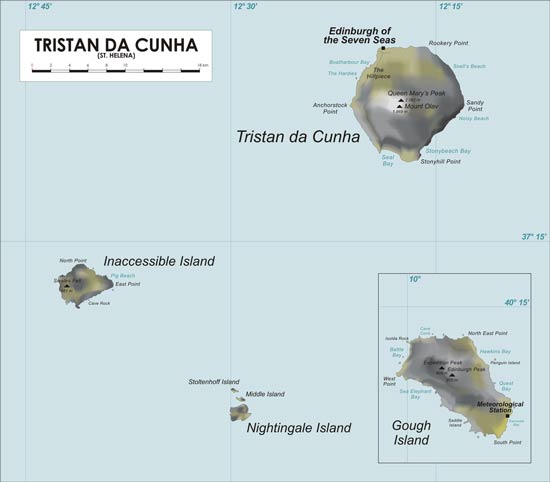
Map shows four islands that comprise the Tristan Archipelago
In 1810, Jonathan Lambert, an American from Salem, Massachusetts, claimed Tristan as his home and annexed it to the United States. He and two other settlers hunted fur seals and sold the pelts to whaling ships that stopped for fresh water. But in 1813, Capt. Charles Richardson of the HMS Semirannis, went ashore, raised his country’s flag and proclaimed the island a British possession. In 1816, Tristan, Inaccessible, Nightingale and Gough Islands were designated colonies and later declared British Overseas Territories. Today, Tristan and her three sister islands comprise the most remote archipelago in the world.
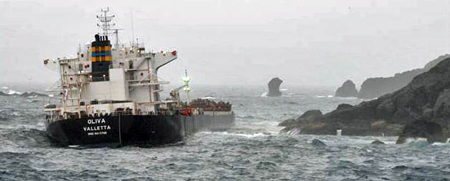
The 75,000 ton cargo ship MS Oliva ran aground and sank off Inaccessible Island, March, 2011
In 1778, Capt. Andre D’etcheverry of the French frigate Etoile du Matin, after failing to find a place to land, coined the name “Inaccessible.” An uninhabited volcanic island 25 miles from Tristan, it’s known for sheer cliffs and inhospitable terrain, Inaccessible and Gough Island–220 miles from Tristan—are UNESCO (United Nations Educational, Scientific and Cultural Organization) World Heritage sites. Home to the world’s largest colonies of sea birds, including albatrosses, petrels and rockhopper penguins, both islands are prime spots for ornithological research. Gough is uninhabited except for a staff of six personnel that man the South African Meteorological Station which was established over 60 years ago. Gough, like Tristan, was named after a seafarer, Capt. Charles Gough of the HMS Richmond. Nightingale, smallest of the islands, 1.5 miles in circumference, lies 18 miles from Tristan. Capt. Gamaliel Nightingale, of the HMS Vengeance, after landing there in 1760, coined the catchphrase, “I found it and I’ll name it.” While exploring, Capt. Nightingale found small cliffs, millions of birds and clumps of Tussock grass harboring countless penguin rookeries. The island, uninhabited but visited for scientific studies, is surrounded by heavy kelp beds which make it difficult for ships to anchor in bad weather.
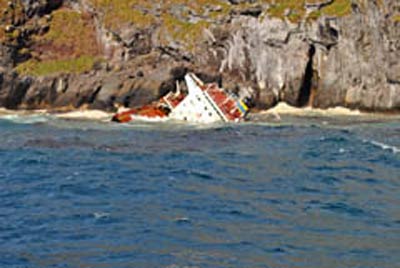
The Ms Oliva sank off Nightingale Island, spilling oil into the pristne waters
An infamous incident occurred on March 16, 2011 when the 75,000-ton cargo carrier MS Oliva—en route from Santos, Brazil to Singapore—ran aground off Spinner’s Point on the northwest promontory of Nightingale Island. Human error was to blame when the first mate misjudged the course coordinates and 300,000 gallons of unrefined petroleum were spilled into pristine waters while the ship broke in two and sank. There were no human casualties, but thousands of rockhopper penguins were soaked with crude oil. Only a small percentage survived as Tristan conservation teams did their best to clean the birds, beaches and waters. The “MS Oliva Disaster” made international news and the islanders were credited for their endless efforts to save the oil soaked aquatic seabirds. The wreck lies in two pieces, resting on its port side in shallow water where wind and waves batter the shoreline.
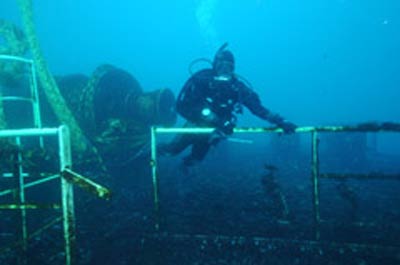
Divers inspected the MS Oliva and declared it unsalvageable
In 1821, the “Blendon Hall Incident” drew the attention of mariners everywhere. The 450-ton East India Company merchant vessel Blendon Hall was lost in the fog while sailing from Jamaica to Bombay, India. Blown off course in heavy seas, she ran aground off Inaccessible Island. Two seamen drowned, but 50 passengers and crew scrambled over the rocks to safety and watched their ship sink. Survivors were marooned for four months while living on fish, birds’ eggs and seal meat. After one failed attempt, another party made it to Tristan in a makeshift boat and sent help to the remaining castaways. In 1836, the American schooner Emily, sailing out of New York, was outfitted as a sealer to hunt the animals for their skins, oil and meat. While moored off Tristan, Capt. Peter Green’s ship dragged its anchor during a sudden storm and sank off the south shore. No lives were lost. Green, however, remained on the island, married an islander and had eight children. A highly respected resident, he became “Headman” of the Settlement and lived to age 94. In 1892, the Italia, a merchant ship sailing from Scotland to Capetown, South Africa, caught fire near Tristan. The quick thinking captain ran his vessel ashore, saving himself and his 16 crew. Two of them, Andrea Repetto and Gaetano Lavarello stayed behind, married Tristian women and had families whose descendants are still on the island today. Other shipwrecks in the archipelago include the Beacon Light, Henry B. Paul, Shakespeare, Helen S. Lee, Mabel Clark, HMS Julia and the Lark.
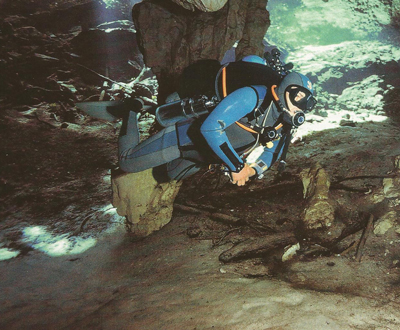
Diver approaches wreck of Blendon Hall, lost in the fog and sunk off Tristan da Cunha in 1821
Ichthyologists enjoy field days meandering among the scattered remains of schooners, barques, brigs and ketches, taking notes and capturing photos of some of the 41 different species of fish found in these waters. Moray eels, soldier fish and lobster seek cover in the shadows beneath barnacle covered planks and beams. Wrasse, grunts, shad and five finger fish cruise over nudibranchs, tubeworms and anemones clinging to the remains of keels and rigging. Whales, dolphins and porpoises, feed on krill mating in kelp beds found in deeper waters not far from the wrecks. A green turtle, devil ray or seven gill shark might veer in from the depths to check out the food supply on the wreckage. Water temperatures average in the mid-60 degrees Fahrenheit during winter and low 70s in summer. Divers are comfortable wearing 3 to 7 mm wetsuits in pristine waters showcasing 50 to 60 foot visibility. The islands retain a cool temperate climate with changing weather patterns softened by the trade winds. Sudden squalls generated by westerly winds are not unusual. Winters aren’t severe. There are no frosts, but snow forms on volcanic peaks. Records show many other ships lost in the Tristan Archipelago. The waters remain virgin territory for new discoveries.
Part I: Remote Island Has Shipwrecks, No Cancer
Part III: Pirates and Buried Treasure on Triristan Archipelago
Author: Ellsworth Boyd
Ellsworth Boyd, Professor Emeritus, College of Education, Towson University, Towson, Maryland, pursues an avocation of diving and writing. He has published articles and photo’s in every major dive magazine in the US., Canada, and half a dozen foreign countries. An authority on shipwrecks, Ellsworth has received thousands of letters and e-mails from divers throughout the world who responded to his Wreck Facts column in Sport Diver Magazine. When he’s not writing, or diving, Ellsworth appears as a featured speaker at maritime symposiums in Los Angeles, Houston, Chicago, Ft. Lauderdale, New York and Philadelphia. “Romance & Mystery: Sunken Treasures of the Lost Galleons,” is one of his most popular talks. A pioneer in the sport, Ellsworth was inducted into the International Legends of Diving in 2013.
12 Comments
Submit a Comment
All Rights Reserved © | National Underwater and Marine Agency
All Rights Reserved © | National Underwater and Marine Agency
Web Design by Floyd Dog Design
Web Design by Floyd Dog Design

Thanks Mr. Boyd for the second installment on this curious locale. I enjoy the historical gems that you have been able to uncover. I’m looking forward to more details in Part III.
Thanks Rick for your kind words. It is indeed a “curious locale.” So very remote and enticing. I’m researching the pirates now. They were on all the islands in the Tristan Archipelago in early times. The remoteness is one of the reasons. Ships would have to travel over a thousand miles to track them down. Read all about it in Part III.
I like your article about Tristan and the other islands in the archipelago. If divers want to dive some of the wrecks, do they have to come in self-contained? Meaning sail there in their own boats since there are no dive operations in these islands? Thank you writing about these interesting remote places. I look forward to Part III.
Thank you for your kind words. I think you will like Part III as well.
Yes, “self contained” is a good way of putting it. Divers would have to have their own boat with an air compressor aboard. It would have to be a very seaworthy boat. If sudden storms come up, there is no safe harbor anywhere. Tristan’s harbor can take only small boats. This archipelago would be a fascinating place to dive. There are undiscovered shipwrecks in these pristine waters.
Lets’s go EB. If we croak enroute or there who cares. Beats sitting around wondering what it would be like if we just said to hell with it and went anyway! You know me, I’ll do it if you will.
Great overview.
After 50 years hopping between Europe and the States, Tristão da Cunha (the original name of the famous Portuguese navigator) is the ideal Island to spend a few months.
Who knows, perhaps I’ll marry a local lady, throw away celular phones, Computers & Tablets and resume a simpler, yet more enjoyable Life…
Obviously, a great deal of books will be a mudt
Yes, several others have said the same thing. At least a visit, if not living there. These are hard working people, dedicated to their jobs and their families. Too bad the rest of the world hasn’t caught on.
Hi
Greta stories! Do you have any info on the SV Coimbra that ran aground at Tristan in 1953? I am busy researching my family, and it would appear that they were involved with this yacht?
Thanks
Tom
Tom: All I can find so far is the SS Coimbra sunk many years ago. Do you have anything on the 1953 wreck of the SV Coimbra? If so send it to me at [email protected]. You mentioned “yacht.” Was it a recreational vessel? (not commercial).
If I find anything I will let you know. I have one book I haven’t checked yet. Stay in touch. I am interested in all wrecks around Tristan da Cunha and surrounding islands. Thanks for your nice comment. A visit to Tristan is on my bucket list. Cheers, Ellsworth
Hi Ellsworth
Some pics heading your way!
Tom
Hi Ellsworth
AOL is blocking the emails I sent you, please see if you can remove them from junk status, or please drop an email to me on my address below.
Thanks
Tom
Thanks Tom. I’ll try your email. Cheers, Ellsworth
(Mine is: [email protected])